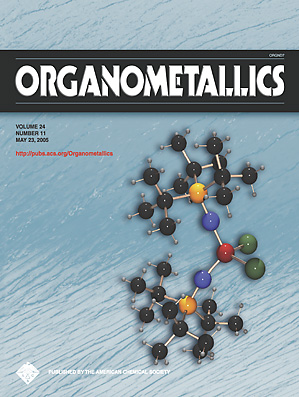







|
|
|
Journal
Publications |
|
Ruthenium Complexes of Six-Electron-Donor
NUPHOS-Type Diphosphines: Highly Selective Catalysts for the
Hydrocarboxylation of Terminal Alkynes.
Simon Doherty, Julian G. Knight, Rakesh K.
Rath, William Clegg, Ross W. Harrington, Colin R. Newman, Robert
Campbell and Hiren Amin, Organometallics 2005, 24,
2633. |
|
Abstract: The ruthenium-p-cymene
complexes [(p-cymene)Ru(1,2,3,4-Me4-NUPHOS)Cl][SbF6]
(2a) and [(p-cymene)Ru(1,4-Et2-2,3-cyclo-C6H8-NUPHOS)Cl][SbF6]
(2b) have been prepared by reaction of [(p-cymene)RuCl2]2
with the corresponding NUPHOS diphosphine in the presence of NaSbF6.
The chloro ligand can be abstracted from these monocations to afford [(p-cymene)Ru(P,P,h2(C)-1,2,3,4-Me4-NUPHOS)][SbF6]2
(3a) and [(p-cymene)Ru(P,P,h2(C)-1,4-Et2-2,3-cyclo-C6H8-NUPHOS)][SbF6]2
(3b), respectively, in which the diphosphine coordinates as a
six-electron donor, bonded through both diphenylphosphino groups and one
of the double bonds of the butadiene tether. In stark contrast, it
proved markedly more difficult to abstract the chloro ligand from either
the BIPHEP or the MeO-BIPHEP monocations [(p-cymene)Ru(BIPHEP)Cl][SbF6]
(4a) and [(p-cymene)Ru(MeO-BIPHEP)Cl][SbF6] (4b),
and even after prolonged reaction times at elevated temperature [(p-cymene)Ru(BIPHEP)][SbF6]2
(5a) and [(p-cymene)Ru(MeO-BIPHEP)][SbF6]2
(5b) formed as a 30% mixture with unreacted 4a and 4b,
respectively. The structures of 2a, as its perchlorate salt, and
2b have been determined by single-crystal X-ray crystallography and
are compared with that of their BIPHEP counterpart 4a.
Unfortunately, it has not been possible to prepare the corresponding
dppb complex [(p-cymene)Ru(dppb)Cl][SbF6] to undertake
a comparative study, since [(p-cymene)RuCl2]2
reacts with dppb under the same conditions as those used to prepare
2a,b to afford the bridged dimer [{(p-cymene)RuCl2}2(m-dppb)]
(6), the identity of which has been confirmed by a single-crystal
X-ray study. Interestingly, 3a undergoes rapid hydrolysis in the
presence of pyridine to give [(p-cymene)Ru{Ph2(O)PC(H)MeCMeCMeCMePPh2}][SbF6]
(7), which contains an unusual unsymmetrical bisphosphine
monoxide pincer ligand formed by oxidation of one of the
diphenylphosphino groups of 1,2,3,4-Me4-NUPHOS and a highly
regioselective syn addition of Ru and H across the butadiene double bond
proximate to the phosphine oxide. Dications 3a,b catalyze
the regioselective anti-Markovnikov addition of benzoic acid to
1-pentyne and 1-octyne to give the corresponding alk-1-en-1-yl esters
with cis-to-trans ratios as high as 95:5, while the corresponding BIPHEP
and MeO-BIPHEP complexes were significantly less selective, catalyst
mixtures formed from 4b giving a 70:30 mixture of cis and trans
alk-1-en-1-yl ester. In contrast, selectivity was reversed with catalyst
mixtures generated from 6, which were 90% selective for
Markovnikov addition to 1-octyne, as might have been predicted for a
ruthenium catalyst coordinated by a single phosphine, albeit one-half of
a bidentate diphosphine. Catalysts based on NUPHOS diphosphines are also
highly active and selective for anti-Markovnikov addition of benzoic
acid to phenylacetylene and give (Z)-styryl benzoate in yields of
up to 85% and selectivities as high as 99:1 with no evidence for the
formation of terminal olefin. In our hands, solutions formed by
activation of 4a,b with AgSbF6 catalyze the
regio- and stereoselective anti-Markovnikov hydrocarboxylation of
phenylacetylene, which was somewhat surprising considering that an
earlier report has claimed that 5b reacts with phenylacetylene to
form a stable catalytically inactive cyclometalation/insertion product. |
| |
|
|
| |
|
|
|



